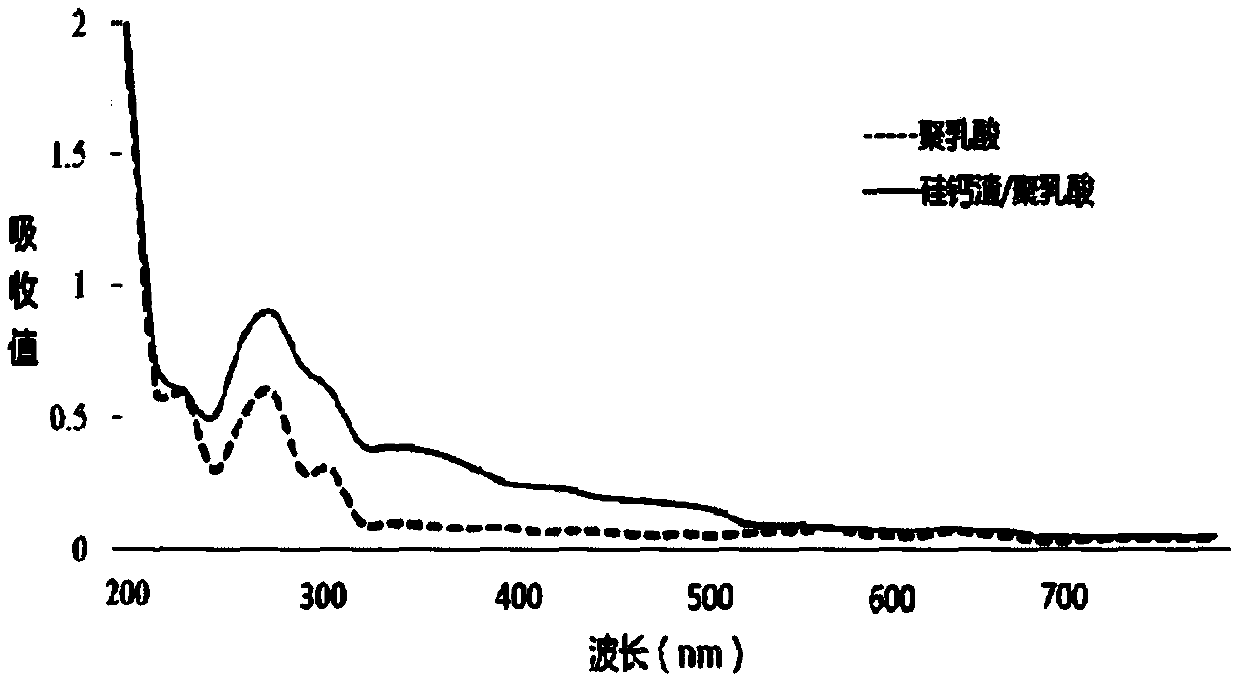Silicon-calcium slag degradation assisted degradation polylactic acid preparation method
A technology of silicon-calcium slag and polylactic acid, which is applied in the field of inorganic nanomaterials and polymer composite materials, can solve the problems of long degradation cycle, poor impact resistance, weak interface bonding force, etc., shorten the degradation cycle, improve mechanical properties, The effect of improving compatibility
- Summary
- Abstract
- Description
- Claims
- Application Information
AI Technical Summary
Problems solved by technology
Method used
Image
Examples
Embodiment 1
[0020] 1) Pretreatment of silicon-calcium slag: Grinding and pulverizing silicon-calcium slag with a grinder, and sieving to obtain silicon-calcium slag fine powder with a particle size of about 4-10 μm;
[0021] 2) Modification of silicon-calcium slag: Add silicon-calcium slag fine powder into oleic acid ethanol solution, the mass volume ratio of silicon-calcium slag fine powder and oleic acid is 1:0.3g / mL, ultrasonically disperse for 30min, and react at 40°C 2-3h, filter and dry;
[0022] 3) Preparation of composite material: premix the modified silicon-calcium slag obtained in step 2) with polylactic acid, the mass ratio of the modified silicon-calcium slag to polylactic acid is 0.4:1, add the two-roll mill to melt blend, melt The blending temperature is 180° C., and the time is 15 minutes to obtain a blended product;
[0023] 4) Hot pressing the blended product obtained in step 3) to obtain a calcium-silicon slag polylactic acid composite material.
[0024] Its absorptio...
Embodiment 2
[0027] 1) Pretreatment of silicon-calcium slag: Grinding and pulverizing silicon-calcium slag with a grinder, and sieving to obtain silicon-calcium slag fine powder with a particle size of about 4-10 μm;
[0028] 2) Modification of silicon-calcium slag: Add silicon-calcium slag fine powder into oleic acid ethanol solution, the mass volume ratio of silicon-calcium slag fine powder and oleic acid is 1:0.5g / mL, ultrasonically disperse for 30min, and react at 60°C 2-3h, filter and dry;
[0029] 3) Preparation of composite material: premix the modified silicon-calcium slag obtained in step 2) with polylactic acid, the mass ratio of the modified silicon-calcium slag to polylactic acid is 0.6:1, add the two-roll mill to melt blend, melt The blending temperature is 180° C., and the time is 15 minutes to obtain a blended product;
[0030] 4) Hot pressing the blended product obtained in step 3) to obtain a calcium-silicon slag polylactic acid composite material.
[0031] After adding ...
Embodiment 3
[0034] 1) Pretreatment of silicon-calcium slag: Grinding and pulverizing silicon-calcium slag with a grinder, and sieving to obtain silicon-calcium slag fine powder with a particle size of about 4-10 μm;
[0035] 2) Preparation of composite material: Premix the silicon-calcium slag fine powder obtained in step 1) with polylactic acid, the mass ratio of silicon-calcium slag to polylactic acid is 0.4:1, add the two-roll mill to melt blend, and melt blend The temperature is 180° C., and the time is 15 minutes to obtain a blended product;
[0036] 3) Hot pressing the blended product obtained in step 2) to obtain a calcium-silicon slag polylactic acid composite material.
[0037] Since the silicon-calcium slag has not been modified with oleic acid, its dispersion in polylactic acid is extremely poor, and the particles are agglomerated in polylactic acid, resulting in a decrease in the mechanical properties of polylactic acid.
[0038] After testing, the tensile strength of the com...
PUM
| Property | Measurement | Unit |
|---|---|---|
| particle diameter | aaaaa | aaaaa |
| tensile strength | aaaaa | aaaaa |
| tensile strength | aaaaa | aaaaa |
Abstract
Description
Claims
Application Information
 Login to View More
Login to View More - R&D
- Intellectual Property
- Life Sciences
- Materials
- Tech Scout
- Unparalleled Data Quality
- Higher Quality Content
- 60% Fewer Hallucinations
Browse by: Latest US Patents, China's latest patents, Technical Efficacy Thesaurus, Application Domain, Technology Topic, Popular Technical Reports.
© 2025 PatSnap. All rights reserved.Legal|Privacy policy|Modern Slavery Act Transparency Statement|Sitemap|About US| Contact US: help@patsnap.com

